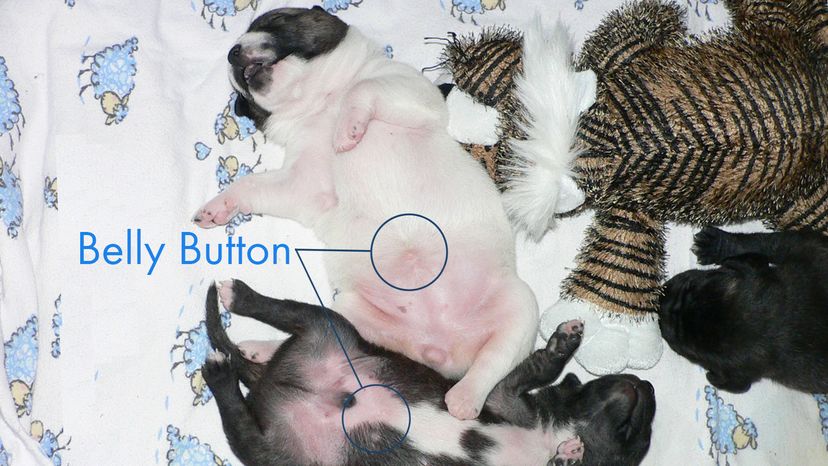
Here's a question we know has been keeping you up at night: Do dogs have belly buttons? Of course they do. I mean, they do, right?
Well, the short answer is "yes," dogs (and cats) have belly buttons. All placental mammals do. Placental mammals are those that give birth to live babies, as opposed to oviparous animals, which lay eggs, and marsupials whose babies develop in their mother's pouch.
Advertisement
While in the womb, placental mammals depend on their mothers to deliver nutrition and oxygen (and remove waste, but that's another, less pleasant, topic) through the umbilical cord. That goes for puppies, too.
Each puppy in a litter has its own umbilical cord that connects its mother's placenta to the puppy's stomach. After giving birth, a mama dog chews through the umbilical cord, leaving a wound where the puppy and cord were connected. The tiny wound on the pup heals quickly into a small, thin line — also known as a navel or belly button. So essentially, belly buttons are just scars.
So, where are these belly buttons on our four-legged friends? You certainly don't notice them like you do on humans.
Well, the navel on a dog is often difficult to locate because of its size — and the fur that quickly grows over it. If you feel compelled to find your dog's belly button, look for it under the fur where the "tufts" meet around the base of your dog's ribs. Sometimes there will be a noticeable patch of darker fur in the area.
And unlike human navels, canine belly buttons are between their nipples, which are located at the base of the rib cage. So, yes, dogs (and cats) have belly buttons — they just look different than human belly buttons. In fact, humans are the ones with the unusual belly buttons. They're relatively large compared to those of other mammals.
And the majority of human navels (about 90 percent) are concave and are often referred to as "innies." A much smaller number of people (about 10 percent) have "outies," that protrude like a "lump" under the skin. Many people incorrectly believe "outies" are caused by the doctor's less than stellar umbilical-cord cutting skills, but the lumps are usually umbilical hernias. Hernias occur when muscles don't heal properly. Instead of growing together, the muscles leave a hole where tissue or intestines poke through.
Placental mammals — that means dogs — can have umbilical hernias too; they look and feel like a bump on their bellies, so it's easy to identify an "outie" belly button on a dog. A dog with a hernia should promptly see a vet to prevent complications.
So, dogs and humans have belly buttons for the same reason. But unlike humans, dogs don't have the extra convenience of a built-in lint catcher, and their belly buttons aren't really good candidates for piercings, either.
It's a crazy world out there. Stay up to date (or go down really fun rabbit holes) with our newsletter!
Advertisement

